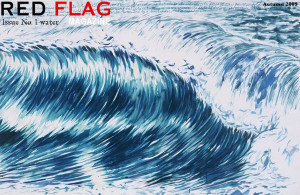The Water Fund : An interview with Financial Advisor John Dickerson
By Nicole Davis
 RED FLAG MAGAZINE: How did you get interested in water?
RED FLAG MAGAZINE: How did you get interested in water?
JOHN DICKERSON: At Summit, we have been water investors since 1980, when I first volunteered as treasurer of a municipal water district. Becoming intrigued with the space due to the cash flows generated by my non-profit utility, I asked Wall Street for their research on water companies but was universally told “we don’t follow that group”. Being a value investor that favors misunderstood and under priced assets, this immediately got my attention and Summit soon started doing its own work on water stocks — first on just the utilities and later on the whole industrial supply chain.
RFM: What does the phrase “water is artificially cheap” mean?
JD: Utility prices come nowhere near the life-cycle costs of actually providing water, and are even less reflective of its true economic and social worth. Many still seem to believe that water simply falls out of the sky and should be basically free, forgetting that it costs hundreds of billions of dollars a year to collect, clean, store and distribute water.
RFM: What are some of the most unknown uses of water, but are integral to keeping the financial world in motion?
JD: Emerging hand-in-hand with the deepening water crises is an increased focus on the concept of “virtual” water – a measure of the water necessary to produce a given commodity or product. Although we rarely think about it, nearly every physical good traded in global economic commerce requires some amount of water in its production: 1300 liters to grow one kilogram of wheat, 15,000 liters for the feed and processing that goes into one kilogram of beef, 400,000 liters for the production of a typical passenger car, etc. The movement of commodities from water-rich to water-scarce regions now represents more than 300 cubic km of water per year, or almost 5% of the water used in global agricultural production annually.
RFM: Can you describe the symbiotic, yet tenuous relationship between water and oil energy?
JD: Simply put, energy is needed to pump, treat, and transport water, and large quantities of water are needed to support the development of energy. The American Council for an Energy-Efficient Economy estimates that water and wastewater treatment facilities account for 35% of energy used in municipalities, at a cost of $6.5 billion per year. On the other side of the equation, thermoelectric power plants, which require large quantities of water for cooling and steam-driven turbines, account for 39% of total U.S. freshwater withdrawals.
RFM: What are some of the best investments in the water sector?
JD: Sorry, we can’t give anything that may be interpreted as investment advice or as a recommendation of a security.
RFM: In the best case scenario, what will happen in terms of the value of investments in the water sector within the next few decades, and what detrimental global changes will occur to create such an upside in the water marketplace?
JD: No disastrous global calamity is necessary for water to be a promising investment. Population growth and crumbling or otherwise insufficient infrastructure are the most important investment drivers, and they are already well in force (if largely ignored).
RFM: What are some of the most interesting and promising water start-ups you have come across?
JD: We do not focus on start-ups, the technology adoption curve in the water industry is extremely slow so emerging tech is not an important consideration for our investment purposes.
RFM: What would you say is the biggest problem facing the U.S. in terms of water today?
JD: The continued focus on supply-side solutions to water scarcity. There are no more rivers to dam, no more sources that can be utilized efficiently. Hopes for a silver-bullet solution in desalination completely ignore the energy side of the equation. Our best hopes for the future are recycling and reuse, demand-side efficiency improvements, and free markets for water rights.
RFM: If you had the opportunity to sit with the president and advise him on what needs to be done about water in this country, what would you say?
JD: INVEST “STIMULUS FUNDS” IN WATER INFRASTRUCTURE. Despite estimates that the United States will need to invest as much as $500 billion over the next 20 years to repair and upgrade its aging and dilapidated water infrastructure, various government stimulus packages, including the $787 billion American Recovery and Reinvestment Act, have earmarked at most just $10 billion for various water projects. Besides the clear advantages imparted to the public welfare, Scott Paul of the Alliance for American Manufacturing estimates that 19,759 jobs are created for every $1 billion invested in water infrastructure – representing the biggest bang-for-the-buck in terms of job creation out of any of the spending initiatives contemplated yet.
RFM: What do you think is the most fascinating thing about water?
Global population has doubled while water use has quintupled over the last century. The global supply of water has remained fixed. By 2025, 1.8 billion will live in regions of absolute water scarcity, and two-thirds of the global population will experience water stress.
